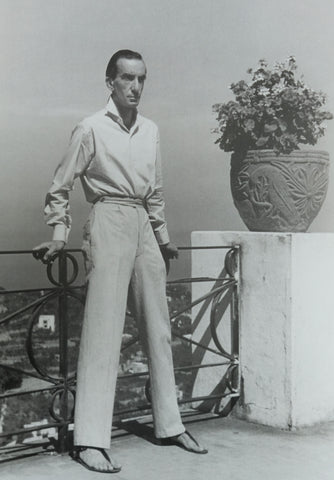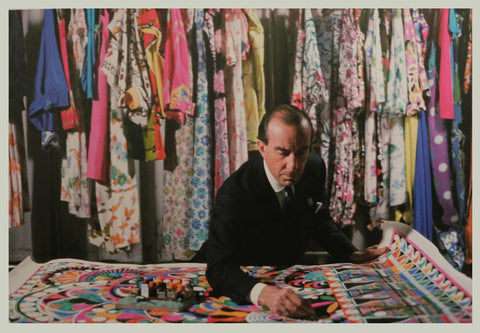
Born into one of the oldest noble families of Florence, Emilio Pucci was a fascinating character who led many extraordinary lives: sportsman, military hero, adventurer, politician, bon viveur and above all a visionary fashion designer who was completely ahead of his time.
At the age of 17 he attended the 1932 Winter Olympics in the USA as part of the Italian ski team, although he did not compete. A few years later he won a full scholarship to Reed College in exchange for developing a college ski team, also designing their outfits and ski runs at Mount Hood, Oregon, where there has been a ski lift named in his honour since 1956. He went on to complete a doctorate in political science in Florence.

Pucci at the Timberline Lodge, Mount Hood, Oregon - coincidentally the location for Stanley Kubrick's The Shining
During World War II his life took an extraordinary turn. He joined the Italian Air Force in 1938 as a bomber pilot, gained the rank of Captain and was decorated for valour. During the war he became close to Mussolini’s daughter Edda and played a key role in a plan to save the life of her husband, Mussolini's former Foreign Minister, Count Galeazzo Ciano, who was on trial for his part in a plot to remove Mussolini from power in 1943. The plan involved delivering some of Ciano's diaries (which were highly critical of Mussolini) to the Gestapo so that they could be bartered for Ciano's life.

Marquis Emilio Pucci with Countess Edda Ciano, Mussolini's daughter, 1939. Note the matching ski outfits!
When the scheme failed, Pucci drove Edda to the Swiss border on 9 January 1944 and ensured her escape. Before departing, Edda wrote pleas to Hitler and Mussolini, and Pucci delivered these letters to an intermediary. He then attempted to flee to Switzerland himself, but he was arrested and transported to San Vittore prison in Milan, where he was tortured by the Gestapo. Pucci managed to get away to Switzerland, where he remained until the end of the war. Ciano was executed by firing squad in 1944.
Pucci had not intended to pursue a career in fashion. In 1947 he was skiing in Switzerland with a female friend, for whom he had designed a ski outfit. The glamorous couple were snapped by a photographer working for Harper’s Bazaar and ended up on the desk of Diana Vreeland, and a fashion legend was born.
Pucci was the first person to design a one-piece ski suit. His sleek designs, using the latest technologies in stretch fabrics, caused a sensation, and he received several offers from American manufacturers to produce them. Instead, he left the Air Force and set up a tiny boutique in the fashionable resort of Canzone del Mare on Capri, which was becoming a favourite destination of the international jet set, when Americans and Europeans flocked to the glamour of the Italy of Cinecittà and La Dolce Vita.

Emilio Pucci in Capri, 1950
Initially, he used his knowledge of stretch fabrics to produce a swimwear line, but he soon moved on to other items such as brightly coloured, boldly patterned blouses, wrinkle-free printed silk dresses and silk scarves. Pucci presented his collection in the first fashion shows in Italy in 1950, working from the family palazzo in Florence, and opened a boutique in Rome. The ethos was about freedom, femininity, modernity and joy, expressed in bright, optimistic colours and rhythmic geometric prints.

Marilyn Monroe wearing silk top and matching Capri Pants
By the 1950s, Pucci was achieving international recognition, and he hit the big time when Marylin Monroe became a fan – when she died in 1962 she was buried in a Pucci dress. Since the 1960s his creations have been worn by the rich and famous from Bardot and Loren to Jackie Kennedy, and later Amy Winehouse. It is a testament to the timelessness of his creativity that both Monroe and Winehouse wore the same design, 45 years apart.

Pucci's Ceramiche design, worn by Marilyn Monroe in 1962, and Amy Winehouse in 2007.
Pucci created an incredibly light and stretchy jersey that could be folded into a small handbag – no ironing required. In 1965 he was commissioned by Braniff Airways, designing the uniforms for the hostesses, pilots and ground crew – including a "bubble helmet" – a clear plastic hood worn by flight attendants between terminal building and aircraft to protect their hairdos from rain. In 1971 he designed the logo for the Apollo 15 moon mission, although the colours were changed to red, white and blue.

Pucci's uniforms for Braniff International, 1965
He lived and worked for most of his life at the Pucci Palace in Florence. Aside from earning the name “The Prince of Prints” he had a political career with the Liberal Party. His clothes are instantly recognised around the world for their bold, witty prints, flattering fabrics and riot of intense kaleidoscopic colours as well as their distinctive message: fun, practical sporty and innovative, reflecting the genius of the man himself.

Emilio Pucci at work in the Palazzo Pucci
Further reading: Pucci by Vanessa Friedman and Alessandra Arezzi Boza

